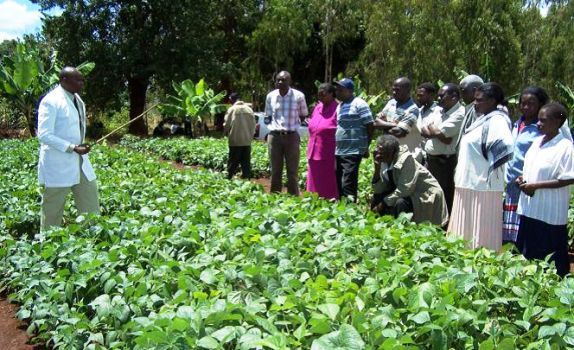
Farmers attending a field day in Western Kenya are taught in the importance of cowpeas. Intensifying the population can increase yields per acre by 144kg. Photo by Mount Kenya University.
A new research report has shown that farmers in Kenya can get up to 144kg more of cowpeas from one acre by intensifying the crop population.
According to the Kenya Agricultural and Livestock Research Organisation cowpeas production per acre in the country ranges from 320kg to 720kg.
Trials that have been done by two international agriculture research organizations have established that with intensification of the population of the crops per acre, farmers can harvest up to 864kg per acre.
The recommended spacing for the cowpeas is 75cm by 75cm. In respect to the current spacing, one requires 53,333 seeds per acre.
But according to the trials done at Kano and Zaria, Northern Nigeria, increasing the seed rate to 160,000 per acre gives up to 864kg per season.
In the new method, the seeds are grown on ridges. Two or three rows are grown on the ridges instead of the usual one. The inter-row space is enough for navigation during weeding and carrying out various management activities.
The increase in the population of the seeds per acre reduces the penetration of sunlight into the ground, therefore, limiting growth of weeds.
Apart from hosting crop parasites and spreading infections, weeds compete for nutrients with the crops, leading to dismal performance.
RELATED ARTICLE: Scientists discover low cost preservation method for cowpeas
Cowpeas are short-season crops that mature with a maximum of four months.
The seeds of this leguminous crop are rich in proteins, carbohydrates, fibre and other important nutrients. The leaves are also edible as vegetables.
The protein component is about 24.5 per cent while carbohydrates cover 63.5 per cent. Fat and fibre contents are two per cent and 6.3 per cent respectively.
That is why it is an important component in the processing of animal feeds and human food.
RELATED ARTICLE: Research institute introduces three varieties of chicken peas suitable for short rain seasons
Given that it matures within three months, it can be a rich source of food fighting hunger and malnutrition if grown during short rains.
With such high productivity, the legume is a good venture for agribusiness.
The study was done by six researchers from the International crop Research Institute for the Semi-Arid Tropics and the International Institute of Tropical Agriculture.
















Comments powered by CComment